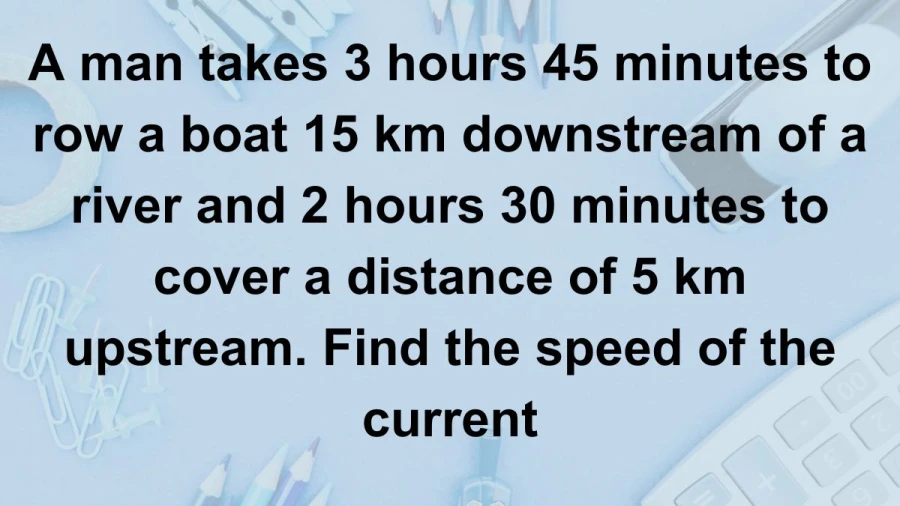If you happen to be viewing the article A man takes 3 hours 45 minutes to row a boat 15 km downstream of a river and 2 hours 30 minutes to cover a distance of 5 km upstream. Find the speed of the current ? on the website Math Hello Kitty, there are a couple of convenient ways for you to navigate through the content. You have the option to simply scroll down and leisurely read each section at your own pace. Alternatively, if you’re in a rush or looking for specific information, you can swiftly click on the table of contents provided. This will instantly direct you to the exact section that contains the information you need most urgently.
A man takes 3 hours 45 minutes to row a boat 15 km downstream of a river and 2 hours 30 minutes to cover a distance of 5 km upstream. Find the speed of the current
Let’s denote the speed of the boat in still water as b km/h and the speed of the current as c km/h.
When the boat is traveling downstream, the effective speed is the sum of the speed of the boat and the speed of the current. So, the speed downstream is b + c km/h.
Article continues below advertisement
When the boat is traveling upstream, the effective speed is the difference between the speed of the boat and the speed of the current. So, the speed upstream is b – c km/h.
We can use the formula:
Speed = Distance / Time
To find the speed of the boat, we have:
- b + c = 15 / 3.75 (downstream)
- b – c = 5 / 2.5 (upstream)
Solving these two equations will give us the values of b and c.
From the first equation: b + c = 15 / 3.75 = 4 km/h
From the second equation: b – c = 5 / 2.5 = 2 km/h
Now, we can solve this system of equations. Adding the two equations together, we get: 2b = 6 km/h So, b = 3 km/h.
Substituting the value of b into one of the equations, we get: 3 + c = 4 ⇒ c = 4 – 3 = 1 km/h
So, the speed of the current is 1 km/h.
Speed, Distance and Time
Speed, distance, and time are fundamental concepts used to describe the motion of objects. They are interrelated through the following formula:
Speed = Distance / Time
This formula allows you to calculate any of the three quantities, given the other two. Here’s a breakdown of each term:
- Speed: This refers to how fast an object is moving and is typically expressed in units like kilometers per hour (km/h), miles per hour (mph), or meters per second (m/s).
- Distance: This refers to the total length or gap between two points and is typically expressed in units like kilometers (km), miles (mi), or meters (m).
- Time: This refers to the duration or interval between two events and is typically expressed in units like hours (h), minutes (min), or seconds (s).
Understanding the relationship:
- Direct proportion with distance: If the speed remains constant, the greater the distance traveled, the longer the time taken (and vice versa).
- Inverse proportion with time: If the distance remains constant, the faster the speed, the less time it takes to cover the distance (and vice versa).
Example:
If a car travels 120 kilometers (distance) at a speed of 60 kilometers per hour (speed), the time taken (time) can be calculated as:
Time = Distance / Speed = 120 km / 60 km/h = 2 hours
This formula is widely used in various applications, like calculating travel times, determining average speeds, and solving motion problems in physics or engineering.
Article continues below advertisement
Article continues below advertisement
Thank you so much for taking the time to read the article titled A man takes 3 hours 45 minutes to row a boat 15 km downstream of a river and 2 hours 30 minutes to cover a distance of 5 km upstream. Find the speed of the current written by Math Hello Kitty. Your support means a lot to us! We are glad that you found this article useful. If you have any feedback or thoughts, we would love to hear from you. Don’t forget to leave a comment and review on our website to help introduce it to others. Once again, we sincerely appreciate your support and thank you for being a valued reader!
Source: Math Hello Kitty
Categories: Math

